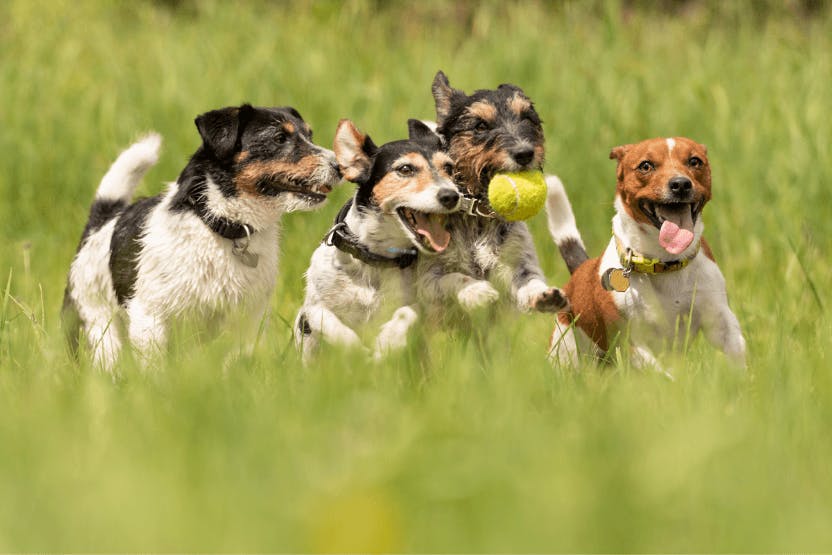Regular exercise: we all need it to stay fit and healthy, and so do our dogs. But
how much exercise does your dog need each day? What are the signs your
dog isn’t getting enough exercise? Is it possible for a pooch to have
too much exercise?
The truth is that the right amount of exercise
for your pet varies depending on a wide range of factors. Keep reading
to find out what they are and how you can work out how much physical
activity your dog really needs.
Factors that affect your dog’s exercise needs
There are 3 main factors that affect how often (and for how long) your dog needs to raise their heart rate: age, breed, and health. Let's take a closer look at each one.
Age
Your dog’s activity requirements change as they grow older. For
example, you need to manage your puppy’s high energy levels alongside
the need to protect developing bones and joints. Meanwhile, senior dogs will
gradually slow down as they age. We’ll take a closer look at the
exercise needs of dogs at different life stages further down the page.
Breed
Your pup’s breed also plays a huge role in determining how much exercise they need. For example, high-energy breeds like
Australian Cattle Dogs,
Border Collies, and Weimaraners will need a whole lot more regular activity than a breed like the Bulldog, Pug, or Basset Hound.
Some dogs also have certain physical features that limit the type or
amount of exercise they can do —
brachycephalic (or flat-faced) breeds
like the
Shih Tzu are a perfect example.
Health
Health issues can also influence your dog’s daily exercise
requirements. For example, heart problems and
arthritis can affect the
type and amount of activity your dog can handle each day, while you
can’t expect an overweight dog to tackle a huge run without building up
their fitness first. Be sure to check with your vet before starting a
new exercise regime.

How much exercise does a puppy need?
Answer: Up to 60 minutes maximum per day, broken up into short sessions of ~10 minutes each
Puppies, including high-energy breeds, may seem like
they’re constantly full of beans, but they don’t have anywhere near the
same level of endurance as adult dogs. As a result, short and sharp
sessions (around 10 minutes) that involve lots of playtime and even
brief walks will work wonders.
Here's how to calculate how much exercise your puppy needs. Multiply
their age in months by 5 — your total is the maximum number of minutes
your dog should exercise each day. For example, if your puppy is 4
months old, they can safely handle 20 minutes of activity per day.
Just make sure not to overdo it.
Taking your puppy for a run or a long walk can place too much strain on
their developing bones and muscles, so save those super strenuous
workouts for when your pooch is a little older.
You should also take care to play safely, since puppies are known to meddle in things they shouldn't. Don't play with them too roughly, and always play with age-appropriate toys. Avoid playing with household items or letting puppies "play-bite" you — this teaches them that this behavior is acceptable, which could become a big problem when they get older.
Related guides:

How much exercise do adult dogs need?
Answer: Between 30 minutes and 3 hours per day
When your pup reaches adulthood, their fully developed body is now
ready to tackle a more rigorous exercise regime. But their breed will
play a huge part in determining exactly what they’re capable of.
High-energy,
athletic, and working breeds require a whole lot of activity — we're talking 2+ hours every day. An
Australian Shepherd, for example, will love to accompany you on a run or
try out doggy sports like
flyball and
agility.
On the other paw, a Pug will be happy with a daily walk and a few play sessions with you. Half an hour of exercise should be "pawlenty" for small and low-energy breeds.
Requirements really do vary greatly between breeds, so ask your vet for advice if you’re unsure about your dog’s exercise needs.
Related guides:

How much exercise do senior dogs need?
Answer: Between 30 minutes and 1 hour of low-impact exercise per day
As they enter their senior years, dogs can start to feel the effects
of a life well lived. Not only might they have less energy than in times
gone by, but the stiff joints and pain of arthritis can also start to
limit mobility. That's why it's a good idea to avoid rough play and intense exercise, as well as slippery or steep surfaces like stairs and ledges where possible.
Regular exercise is still essential for any senior
dog’s wellbeing, but you’ll need to manage your pooch a little more
carefully. A daily walk is always a good idea, while swimming is a great
form of low-impact exercise for dogs with arthritis. Always let your dog set the pace, and never force them to exert themselves if they're clearly tired.
Regular training sessions will also help your dog’s mind stay sharp while keeping them active at the same time.
Related guides:
Benefits of exercise for dogs
What happens if my dog doesn’t get enough exercise? Does it really
matter all that much if they put on a few extra pounds? Why is exercise
so important?
A lack of exercise can have far more serious
consequences for your dog than merely making them look a little chunky.
From arthritis to heart problems, being overweight or obese can have
potentially life-changing health consequences.
But insufficient
activity can also affect your fur-baby’s mental wellbeing and behavior. A
dog that doesn’t get enough daily exercise can become anxious,
stressed, and bored. This can prompt them to act out and use destructive
behavior to alleviate boredom, use up some energy, or just try and get
your attention.
That’s why it’s worth remembering that you don’t
just need to give your dog a physical workout; you also need to
encourage them to exercise their mind.
Can dogs exercise too much?
Unfortunately, yes! We’ve already talked above about the importance
of restricting exercise for puppies and dogs with health issues, but
it’s also essential to avoid over-exercising a perfectly healthy adult
dog.
From sore and stiff muscles to damaged paw pads, limping, a lack of energy, unnecessary weight loss, and even
heatstroke, there are many different symptoms of too much exercise.
So
if you notice your dog slowing down or struggling, don’t force them to
go any further. Recognize the signs that they’re not at full health and
work out what needs to be done to fix the problem.


